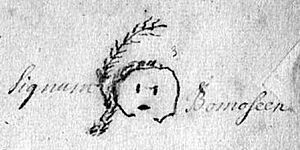Treaty of Portsmouth (1713) facts for kids
The Treaty of Portsmouth, signed on July 13, 1713, brought an end to fighting. It was signed between the Abenaki people, a Native American tribe, and the British areas of Massachusetts Bay and New Hampshire. This agreement renewed an earlier treaty from 1693. That treaty was made by the Abenaki with Governor Sir William Phips. Both treaties were attempts to create peace between the Wabanaki Confederacy and the colonists after Queen Anne's War.
What Was Queen Anne's War?
During a big war in Europe called the War of the Spanish Succession, France and England started fighting. This conflict spread to their colonies in the New World, where it was known as Queen Anne's War. In North America, New France (French colonies) and New England (British colonies) fought for control of the land between them. The French teamed up with the Abenaki tribes as their allies.
Sometimes, with French help, Native American groups attacked many English settlements along the Maine coast. These places included Portland, Scarborough, Saco, Wells, York, and Berwick. Attacks also happened in New Hampshire at Hampton, Dover, Durham, and Exeter. Further south in Massachusetts, towns like Haverhill, Groton, and Deerfield were attacked. Deerfield was the site of a famous event called the Raid on Deerfield. Homes were burned, and people were either killed or taken to Canada.
However, the Treaty of Utrecht in 1713 brought peace between France and England. As part of this agreement, Acadia (a French colony) became British land. When the Native American tribes realized they could no longer rely on the French for protection, their leaders, called sachems, looked for a truce. They suggested a peace meeting in Casco. Joseph Dudley, who was the governor of Massachusetts and New Hampshire, agreed to the meeting. But he chose to hold it in Portsmouth, New Hampshire, instead. Portsmouth was safer because it was protected by the cannons of Fort William and Mary.
What the Agreement Said
On July 11, 1713, Governor Dudley and important people from New Hampshire and Massachusetts Bay met with leaders from several Abenaki tribes. These included the Amasacontee, Maliseet, Norridgewock, Pennacook, Penobscot, and Sokoki tribes.
The agreement was read aloud to the sachems by people who could translate. On July 13, eight of these leaders signed the treaty using their special totemic pictograph symbols. It is important to know that some historians have found that British politicians and translators sometimes tricked the Wabanaki tribes. Because of this, the Wabanaki later said that some parts of the written treaty were different from what was agreed upon verbally. This was especially true for British claims to have power over them. Other leaders signed the next year after a similar meeting.
The Native American leaders agreed to:
- Say they were loyal subjects of Queen Anne.
- Stop all fighting against British people and their property.
- Let English settlers return to their old homes without trouble or claims from the Native Americans.
- Only trade at English trading posts that were approved and managed by the government.
- Not come close to English farms or settlements south of the Saco River. This was to "prevent mischiefs and inconveniences."
- Deal with any problems in an English court, instead of seeking "private revenge."
- Admit they had broken peace agreements made in 1693, 1699, 1702, and 1703. They asked for forgiveness.
- Not make any secret deals with the French against the English. If such a deal existed, they would reveal it.
- Ask the Queen for mercy and forgiveness for past rebellions and broken promises.
At the signing of the Treaty of Portsmouth, leaders from the St. John River Maliseet, Mi'kmaw (Mi'kmaq), and Abenaki nations from Acadia were also present.
What Happened Next?
The English did not keep all their promises in the treaty. Massachusetts did not set up official trading posts as promised. These posts were supposed to sell goods cheaply and fairly to the Native Americans. Because of this, the tribes had to keep trading their furs with private traders. These traders were known for cheating them.
Also, the Native Americans saw the British building blockhouses (small forts) on their lands as a threat. They also did not like that settlers kept moving onto lands they claimed. Their unhappiness was encouraged by Sebastien Rale and other French Jesuit priests. These priests lived with the tribes and promoted the interests of New France.
Because they felt the British had broken the Treaty of Portsmouth, the Abenaki started raiding British settlements again. This led Governor Samuel Shute to declare war against the Eastern Native American groups on July 25, 1722. This conflict became known as Father Rale's War. The struggles over land borders between New France and New England continued until the Treaty of Paris in 1763.
Images for kids






